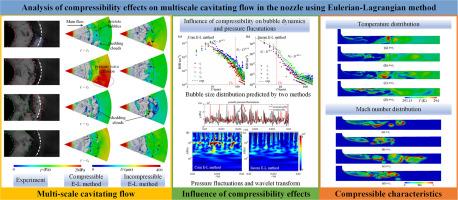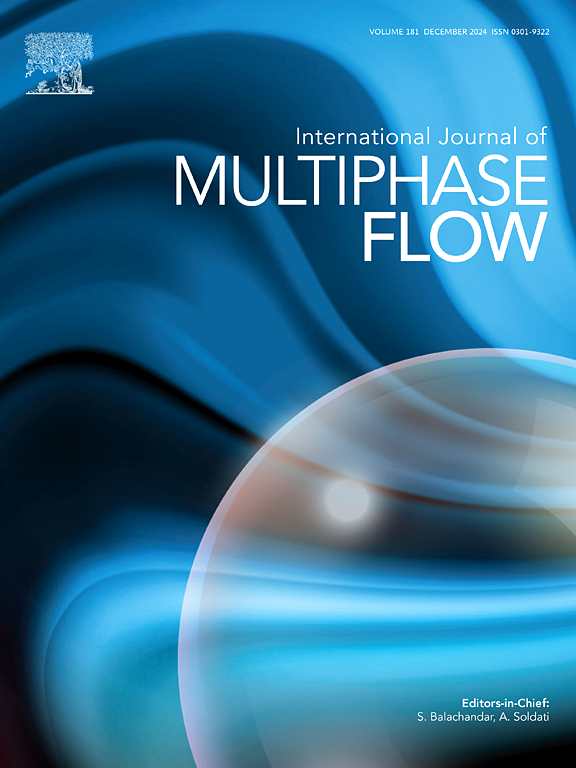Analysis of compressibility effects on multiscale cavitating flow in the nozzle using Eulerian-Lagrangian method
IF 3.8
2区 工程技术
Q1 MECHANICS
International Journal of Multiphase Flow
Pub Date : 2025-08-06
DOI:10.1016/j.ijmultiphaseflow.2025.105412
引用次数: 0
Abstract
A compressible two-way coupling Eulerian-Lagrangian (E-L) method is developed to investigate the compressibility effects on multiscale cavitating flow inside a nozzle. The compressible Navier-Stokes (N-S) equations and compressible Rayleigh-Plesset (R-P) equation are introduced to fully describe compressible effects. Compared with the traditional incompressible E-L method, the compressible E-L method more accurately simulates the characteristics of unsteady cavitating flow, including cavity shedding frequency, mean cavity length and bubble size distribution. Results show that compressibility exacerbates the instability of cloud cavitation, causing macroscopic cavities to break into microbubbles more frequently, further increasing the number of bubbles and expanding their distribution. Further analysis reveals that compressibility effect amplifies mid- and high-frequency bands of pressure fluctuations, especially in the cavity tailing region where only discrete bubbles exist. Additionally, the compressible E-L approach avoids the problem of pseudo-pressure pulsation caused by computational simplification in the incompressible E-L approach. The variation of velocity divergence is driven not only by water-vapor mass transfer but also by density changes in compressible cavitating flow. The temperature distribution indicates that low temperature always exists inside the attached cavity due to evaporation and heat absorption. Strong temperature fluctuation, reaching up to 1.5 K, occurs during the upstream movement of the re-entrant jet and the cavity shedding process. The Mach number distribution illustrates that transient supersonic flow appears only in the wake of the attached sheet cavities and at the shedding cloud interface. These findings provide deeper insights into the multiscale cloud cavitation instability induced by compressibility effects.

用欧拉-拉格朗日方法分析喷嘴内多尺度空化流动的可压缩性影响
建立了一种可压缩双向耦合欧拉-拉格朗日(E-L)方法,研究了可压缩性对喷管内多尺度空化流动的影响。引入可压缩的Navier-Stokes (N-S)方程和可压缩的Rayleigh-Plesset (R-P)方程来全面描述可压缩效应。与传统不可压缩E-L方法相比,可压缩E-L方法更准确地模拟了非定常空化流动的特征,包括空腔脱落频率、平均空腔长度和气泡尺寸分布。结果表明,可压缩性加剧了云空化的不稳定性,使宏观空腔更频繁地破裂成微泡,进一步增加了气泡的数量,扩大了气泡的分布。进一步分析表明,压缩效应放大了压力波动的中高频波段,特别是在只有离散气泡存在的空腔尾区。此外,可压缩E-L方法避免了不可压缩E-L方法中由于计算简化而产生的伪压力脉动问题。在可压缩空化流中,速度散度的变化不仅受水汽传质的影响,还受密度变化的影响。温度分布表明,由于蒸发和吸热作用,附着腔内始终存在低温。射流上游运动和腔体脱落过程中温度波动较大,最高可达1.5 K。马赫数分布表明,瞬态超声速流动只出现在附片腔的尾迹和脱落云界面处。这些发现对压缩性效应引起的多尺度云空化不稳定性提供了更深入的认识。
本文章由计算机程序翻译,如有差异,请以英文原文为准。
求助全文
约1分钟内获得全文
求助全文
来源期刊
CiteScore
7.30
自引率
10.50%
发文量
244
审稿时长
4 months
期刊介绍:
The International Journal of Multiphase Flow publishes analytical, numerical and experimental articles of lasting interest. The scope of the journal includes all aspects of mass, momentum and energy exchange phenomena among different phases such as occur in disperse flows, gas–liquid and liquid–liquid flows, flows in porous media, boiling, granular flows and others.
The journal publishes full papers, brief communications and conference announcements.

 求助内容:
求助内容: 应助结果提醒方式:
应助结果提醒方式:


